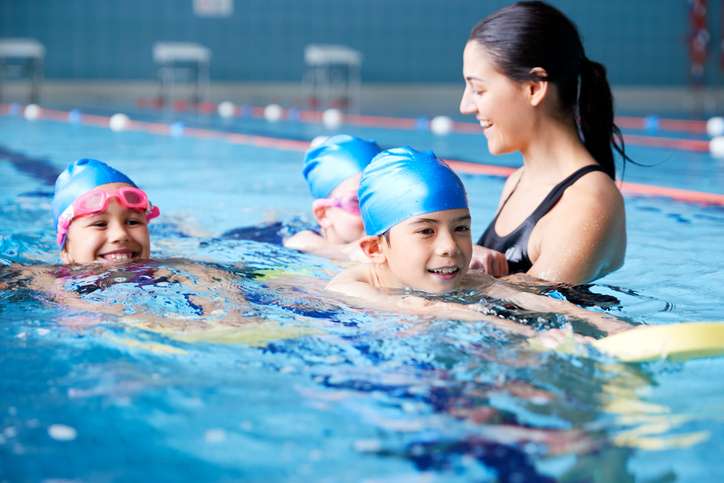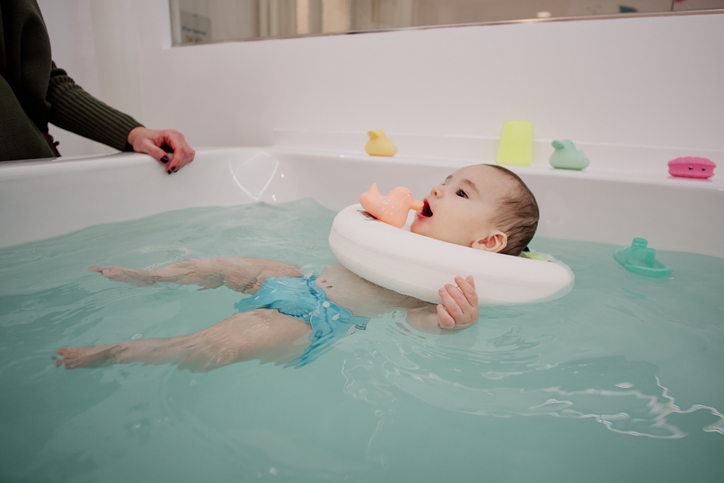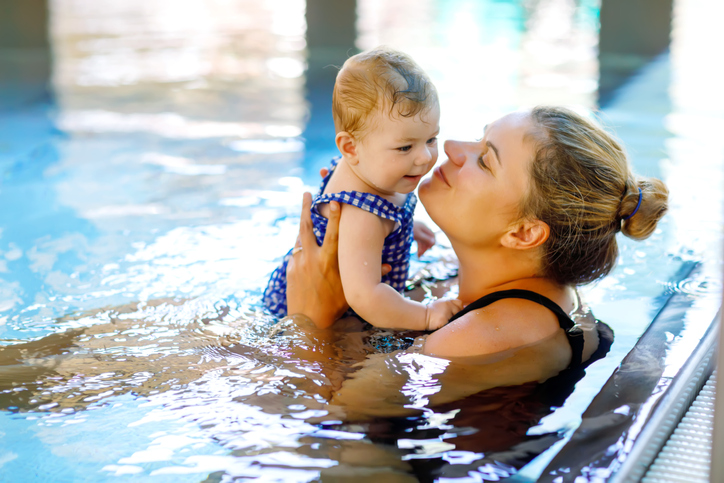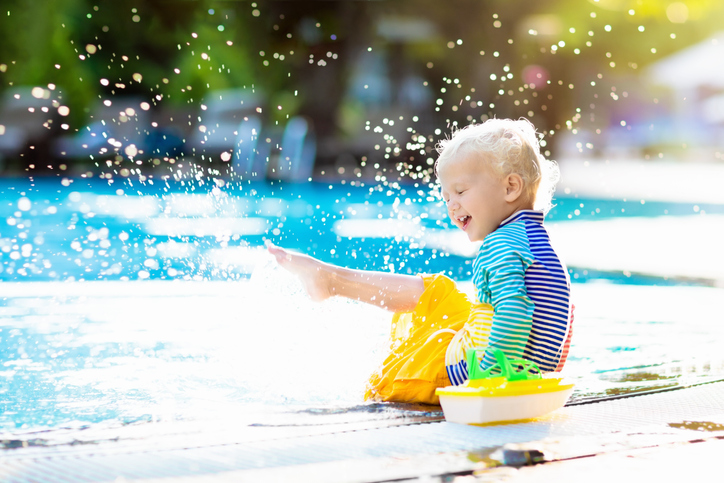Swimming Lessons for Kids: How to Prepare Them for the Pool

Swimming is an amazing skill that will not only keep your kids active, but it could also save their life. The Centers for Disease Control and Prevention (CDC) notes that “drowning is the second-leading cause of unintentional injury death behind motor vehicle crashes for children ages 1–14.” They also report that an average of 11 children under the age of 14 die every single day from drowning.
Swimming lessons are a simple solution for keeping your child safe. This leads many parents to question when their kids can start swimming classes and what types of lessons are available depending on the age of their child. We have the details to keep you from floundering!
Related: Is My Child Ready for Swimming Lessons?
When To Start Swim Lessons
According to the American Academy of Pediatrics, children should start working on their swimming skills and learn swim safety as early as their first birthday. However, many facilities offer private swim lessons that are tailor-made to teach children as young as six months of age how to simply save their life if they were to fall into a body of water.
While this may seem early, it is imperative that you remember that drowning does not discriminate. Moreover, pools are not the only place where drowning occurs. In fact, for children under the age of one, two-thirds of drownings occur in the bathtub. That is why enrolling your little ones in swim programs is so important. Here are the best ways to start teaching these life-changing techniques.
Simple Tips For Keeping Your Kids Safe In The Water
Begin At Bathtime

While the age-old story regales of parents simply throwing their children into the water to teach them how to swim, it is always best to ease your kids into learning this skill. Therefore, before their first swim lesson ever begins, take the time to fill up the bath, cradle their head and buttocks, and let them feel what it is like to float.
This is something that should be done during every bathtime to help them become accustomed to the water. It will also aid in getting them comfortable with their back float, which is one of the main pillars of the swim-float sequence that is taught in survival swim classes. Moreover, this fun activity can help them to build other key water skills that they will use throughout their lessons. Thus, encourage movements like splashing and kicking.
Enroll Them In Self-Rescue Courses
As someone who has enrolled their child in these lifesaving courses, it is important to note that these water safety classes are harder on the parent than the child. That being said, it is well worth the effort and the investment. You will be absolutely astounded at what your child can do within a few short weeks.
Each class is approximately ten minutes long and you will attend four to five sessions per week for six to eight weeks. While this seems like a very small amount of time, ten minutes of instruction for infants and toddlers is equivalent to an adult treading water for forty minutes without a break!
The first time your baby meets their swim instructor, they will work on breath control. This will build up to learning how to flip over and float for extended periods of time. Finally, depending on the program that you choose as well as the age of your child, the instruction will end with them working on how to swim to safety.
Whether you choose Infant Aquatics or Infant Swim Resource, these national programs are designed to help your child learn how to flip over and float if they were to fall into any body of water. Not only that, but their final test involves them showcasing this skill fully clothed in winter attire!
Sign Up For Beginner Swimming Lessons For Kids

Once your child knows how to float, a swim teacher can begin teaching them the basics of navigating the water. This will involve learning skills like submerging for short periods of time, holding their breath underwater, swimming to various locations in the swimming pool, and most importantly, finding a safe exit. They will also be introduced to water etiquette. These classes normally occur during the preschool years but can start sooner if your child was enrolled in survival classes.
However, as many parents know, once your child hits two, they seem to find all of their feelings at once. This can lead to mixed emotions about learning to swim. Make sure to validate these feelings and reassure them that their teacher is there to help them learn and intervene if something goes wrong.
This should be a positive experience so be their cheerleader throughout the process. Let them know you are proud of their efforts and progress and find ways to reward them as they reach the various milestones of the classes.
Make Lessons A Regular Activity
Most importantly, maintenance is key. Talking lessons will ensure safety for a certain period of time, but if the child does not have the ability to practice and conserve the skills that they learned, they will be lost over time.
In addition, kids under six years old who are going through regular growth spurts and have not fully mastered the strokes should get extra attention when it comes to swimming lessons. Their center of gravity will change abruptly over time, making regular adjustments necessary.
Engage With Your Child In The Pool
In order to make your child feel comfortable in water environments and squander any fears that they may have, it is also important to engage in fun games and activities on top of their lessons. This can include blowing bubbles in the soap-free bath water, going to splash pads and the pool, as well as buying toys to make water play more exciting.
Additionally, YOU need to get involved! Young children learn best through imitation so show them how it is done and praise their hard work as they mimic your movements. Also, continue to work on floating in the pool with the help of another adult. One person should be at either end of their body to help support them until they are fully comfortable.
Furthermore, take the time to teach them how to get in and out of the water and always ask them where the exit is located prior to getting in the pool. This should be done no matter how many times they have visited that specific facility.
Introduce Swimming Strokes
Once your child can move through the water with no assistance, it is time to proceed to courses that teach them the various strokes. Freestyle is the most commonly known swimming style. Mastering this technique will lead to introducing harder strokes like the backstroke, breaststroke, and butterfly.
For those kids who have an aptitude for this sport, joining a swim team can be a great way to improve these skills, stay healthy, and build friendships along the way. Most community pools offer lessons or have instructors who partner with their facilities. Country clubs are another fantastic location to find lessons. You can also search online to find local services offered in your area.
Proper Swimming Gear & Guidelines To Consider
Everyone knows that a swimsuit is needed for time spent in the water, but if your child is not potty trained, then a swim diaper will be necessary. Many times the instructor will ask that your child also wears a regular diaper under this piece of swim gear as an extra precaution. Once they get older, flippers and goggles may also become necessary. Therefore, make a point to speak with the teacher about what they require prior to the start of lessons.
Furthermore, we have all been told the advice to wait thirty minutes after eating before entering the water. However, with infants and toddlers, this window can expand greatly. Talk to the instructors about the recommended time frame to withhold food before each lesson. Many will require as many as four to six-hour windows of time without dairy, fruits, vegetables, and proteins. If this is the case, morning lessons may be preferred.
Finally, talk to the teachers about their stance on life jackets and puddle jumpers. While these safety devices should always be worn on boats and when visiting lakes and oceans, they can become a hindrance to learning survival swim skills. The goal of these classes is to teach your kids to stay afloat on their backs. Conversely, these accessories put them in a vertical position, which most toddlers cannot maintain for long periods of time.
Safety Skills To Address With Your Child
We never want water to become a place that our kids fear, but it is crucial that you stress to your kids that they are never to be close to the water without the supervision of an adult. Also, make a point to establish rules for the water.
You want to make it clear that pushing and shoving others in the water is never allowed and that they should not run by the pool. With older kids, make explicit rules about jumping, diving, and more daring stunts that they may be tempted to try. Lastly, it would behoove all parents to become CPR certified. This can ensure that if the unthinkable happens, you are prepared to intervene.
Sun Safety & Swimming

Finally, as a veteran Meteorologist, I would be remiss if I didn’t mention sun safety. If your swim lessons are occurring outside, make a point to slather on the sunscreen at least 30 minutes prior to your child’s lessons. Also, remember to apply to areas where the swimsuit or swim clothing may move or ride up.
Swim shirts and rash guards are great options to include as part of their swim apparel. Better yet, consider clothing made with sun protective fabrics. Look for a UPF of 50+ to help block out 98% of the sun’s harmful rays. Last, but certainly not least, remember that early morning lessons and cloudy days do not preclude burns from happening.
Be proactive with your child’s safety both in the water and on land!

